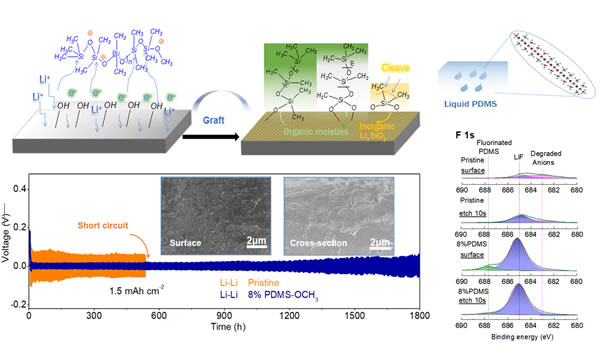Lithium metal has a very high theoretical specific capacity and a very low oxidation-reduction potential, and is expected to become the next-generation anode material. When it is matched with the conversion reaction type sulfur-based and fluorine-based positive electrodes, lithium metal batteries (LMBs) with energy density as high as 500-900 Wh kg-1 are expected. However, the growth and spread of the lithium dendrites at the negative terminal easily lead to poor cycle stability of the lithium metal battery and have the safety risk of battery short circuit; the extruded lithium dendrites may also damage the solid electrolyte interface (SEI) layer or form a "dead" "Lithium", with the increase of the specific surface area and porosity of the lithium metal anode, the consumption of the electrolyte is intensified, and at the same time, the SEI accumulates thicker and causes electrode passivation. These unfavorable factors will lead to the increase of battery impedance and over-potential, causing the decline and fluctuation of Coulomb efficiency (CE), which seriously limits the development of lithium metal batteries. Adjusting the SEI component by adding low-level electrolyte additives is a simple and effective strategy to enhance the SEI film and improve the negative electrode interface to delay the growth of lithium dendrites, and the enhancement effect of SEI depends on the degradation of the additive and the reducing Li surface reaction process. In view of the poor flexibility of the SEI layer with a single inorganic component and the complex operation of the existing organic-inorganic hybrid SEI layer, the team of Li Chilin, a researcher at the Shanghai Institute of Ceramics, Chinese Academy of Sciences, proposed a simple and effective interface in-situ catalytic graft Strategies to achieve high-efficiency stability and dendrite suppression of lithium metal battery anodes. Related research was published in "Advanced Functional Materials" (Advanced Functional Materials, 2019, 1902220, DOI: 10.1002 / adfm.201902220). In this work, the research team used the liquid polydimethylsiloxane (PDMS-OCH3) terminated by the -OCH3 group as a graftable additive to achieve its "graft" on the surface of lithium metal through the action of electrochemical potential and electric field. "And" fragmentation "reactions. The thin "skin" of Li2O and LiOH naturally present on the surface of lithium metal can catalyze the dissociation reaction of PDMS-OCH3 under the action of charge transfer. The broken large molecules can be grafted to the surface of lithium metal, while smaller molecules can Densified into inorganic LixSiOy fast ion conductor. Such organic-inorganic hybrid interface phase (ie, grafted SEI) is further enhanced by the high concentration of LiF injected during the electrochemical process. The combination of hard inorganic components of LiF and LixSiOy can provide fast ion channels and interfaces, realize the ionization effect of the ion current, and act as a barrier to the growth of lithium dendrites; while the soft PDMS branches can enhance the flexibility and cushioning of the entire SEI effect. Using liquid PDMS-OCH3 as an additive to the carbonate system, the negative electrode under its graft protection can give Li | Li symmetrical batteries a stable cycle of up to 1800 h, while achieving a small potential polarization of about 25 mV. Li | Cu asymmetric cells can achieve a Coulomb efficiency of up to 97% under the conditions of high current density and high surface capacity. In terms of lithium metal densification and SEI stabilization, liquid PDMS additives have more significant advantages than other solid silicone additives with weak grafting ability. Recently, the team of Li Chilin has made a series of progresses in the research on the modification of the negative electrode interface of lithium metal batteries. They have proposed functional addition / fillers and conformal coating methods to design stable artificial SEI layers. They are the first to propose a two-dimensional carbon-nitrogen polymer (C3N4) Strategies for enhancing electrolytes to inhibit the growth of lithium dendrites (ACS Appl. Mater. Interfaces 2017, 9, 11615), and proposed a method of in-situ plating of porous magnesium metal networks to stabilize the reversible cycling of lithium anodes (ACS Appl. Mater. Interfaces 2018, 10, 12678), the first to propose a class of lithium-rich fluorine-based open-frame solid electrolyte high ionic conductivity and its homogenization effect on lithium ion flow (Energy Storage Mater. 2018, 14, 100; ACS Appl. Mater. Interfaces 2018 , 10, 34322), a metal-organic framework (MOF) solid additive is proposed to trigger a high-concentration LiF in-situ injection of Zr-oC-based SEI composite enhancement strategy (ACS Appl. Mater. Interfaces 2019, 11, 3869), and a sericin protein protection Shaped coating method to achieve air-stabilized lithium metal anode and high rate Li-S battery (J. Power Sources 2019, 419, 72), proposed to induce lithium metal conformal coaxial deposition Alloy three-dimensional bone structure (ACS Appl. Energy Mater. 2019, DOI: 10.1021 / acsaem.9b00573). The above series of research work have been funded and supported by the National Key R & D Program and the National Natural Science Foundation of China. A waterborne epoxy resin floor system, which is characterized by comprising a plain stratum, a primer layer on the plain stratum, a putty layer on the primer layer, a topcoat layer on the putty layer, and a finishing paint on the topcoat layer Layer, the working principle of the present invention is: tobacco, food, schools, precision manufacturing, biopharmaceuticals, instrumentation, underground garages and other products are environmentally friendly and clean the ground. The invention has the characteristics of ecology, health, environmental protection, no pollution, safe construction, good air permeability of the paint film, wear resistance, good adhesion, and good hiding power. Water-based Environmental Protection Floor System Anti Slip Coating,Water-Based Indoor Coating ,Waterborne Resin Indoor Coating,Mirror Effect Epoxy Floor Painting Eternity International Trading Co;Ltd , https://www.e-tygroup.com
Liquid polydimethylsiloxane interface in-situ catalytic grafting to achieve dendrite-free lithium plating and highly reversible lithium metal batteries